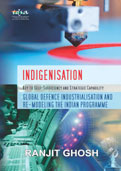You are here
Indigenisation: Key to Self-Sufficiency and Strategic Capability

About the Book
The book attempts to study the defence industrialisation process that has been adopted by the militarily developed and developing nations to analyse, orient and adapt their best practices to the Indian defence industry and technological base. The analysis reveals that there is a requirement to re-assess, re-align & re-model the Indian defence industry apparatus in line with the vision of accelerating indigenisation, self-sufficiency and strategic capability, as pertaining to military systems. The book in its introductory chapter reviews the evolution and current realities of the Indian Defence Industry to arrive at the objective and scope of the research work. In the second chapter it reviews the journey of defence industrialisation in India up to 2015. Next, it reviews two fast-upcoming defence industries of Israel and South Korea to draw important takeaway’s for India. This is followed by analysing the international practices that have been adopted by the defence industry of two leading military nations i.e. the US and China. Such an analysis further brings out valuable defence industry experiences and vital lessons for the defence planners. The book in its concluding chapter suggests three plausible options for remodeling the Indian programme, discusses the most pragmatic option and the resultant feasible model in detail, recommends the way ahead for India before finally suggesting an action plan for MAKE IN INDIA in the Defence Sector.
About the Author
Brig Ranjit Ghosh is a Senior Fellow at the Defence Economics and Industry Centre of IDSA. He has had varied operational and staff experience of 32 years in the Indian Army. As Commandant and Managing Director of an Army Base Workshop he was responsible for planning and executing the re-capitalisation programme of Infantry Combat Vehicles (ICV) and Armoured Recovery Vehicles (ARVs) of the Indian Army. As Deputy Director General at the Integrated Headquarters of MOD (Army), he was associated with the ongoing defence procurements and handled the Ordnance Factories (OFs), Defence Public Sector Undertakings (DPSU’s), Defence Research and Development Organisation (DRDO) and the Private Sector, on issues relating to the induction and sustenance engineering activities of military equipment and weapon systems. He is an alumni of the prestigious Indian Institute of Technology (IIT) Madras, the College of Defence Management (CDM), Secunderabad and the National Defence Academy (NDA), Khadakwasla. During his M Tech programme he stood first in the order of merit while specialising in Maintenance Engineering and Management from IIT Madras. He also has a degree of Masters in Management Studies (MMS) from the Osmania University in Defence Management.
CONTENTS
- Introduction
- Military Capability Development and Sustenance1
- Evolution of Indian Defence Industry
- Current Realities of Indian Defence Industry
- Objective and Scope of the Research Work
- Defence Industrialisation in India: The Journey Upto 2015
- Comprehensive National Power
- National Security and Military Capability Development
- Defence Planning in India
- Defence Research and Development (R&D)
- Ordnance Factories (OF’s)
- Defence Public Sector Undertakings (DPSU’s)
- Private Sector Participation
- Defence Offsets
- Sustenance Engineering and Maintenance Management Aspects:Drivers for Self Sufficiency and Strategic Capability of Importedand Indigenous Systems
- Israeli Defence Industry and Takeaways for India
- Evolution and Growth
- verview—Trends in Defence Industry Activities
- Government Support
- Procurements
- R&D
- Exports
- Privatisation
- Private Sector
- Lessons for India
- South Korean Defence Industry’s Lessons for India
- Evolution and Growth
- verview-Trends in Defence Industry and Defence Reform -2020 Plan544.3Government Support554.4Defence Acquisition Programme Administration (DAPA)
- Procurements
- R&D
- Korea Institute for Defence Analyses (KIDA)
- Exports
- Private Sector
- Lessons for India
- Chinese Defence Industry’s Transformational Aspects for India
- Evolution and Growth
- Overview and Trends
- Government Strategic Objective Budgetary Support andProcurement
- Indigenous Innovation and Technology Development Strategy
- R&D
- Exports
- Private Sector
- Major Reforms Programmes
- Foreign Investments
- Lessons for India
- US Defence Industrialisation and Reforms: Lessons for India
- Evolution and Growth
- Overview and Trends
- Defence Industrial Base
- Sequestration
- Procurements and Acquisition Process
- Indigenous Innovation and Technology Development Strategy
- R&D
- Exports and Markets
- Privatisation
- Major Reforms Programmes
- Foreign Investments
- Lessons for India
- Re-modeling Indian Defence Industry Apparatus forAccelerating Indigenisation, Self-Sufficiency andStrategic Capability
- Introduction
- Options Available For Re-modeling the Indian DITB
- Remodeling Indian Defence Industry Apparatus
- Way Ahead for India
- Suggested Action Plan For MAKE IN INDIA in Defence Sector
Index
Order Hard Copy
Please email us at adps.idsa [at] nic.in or call +91-11-2671 7983 (Ext. 7303)


